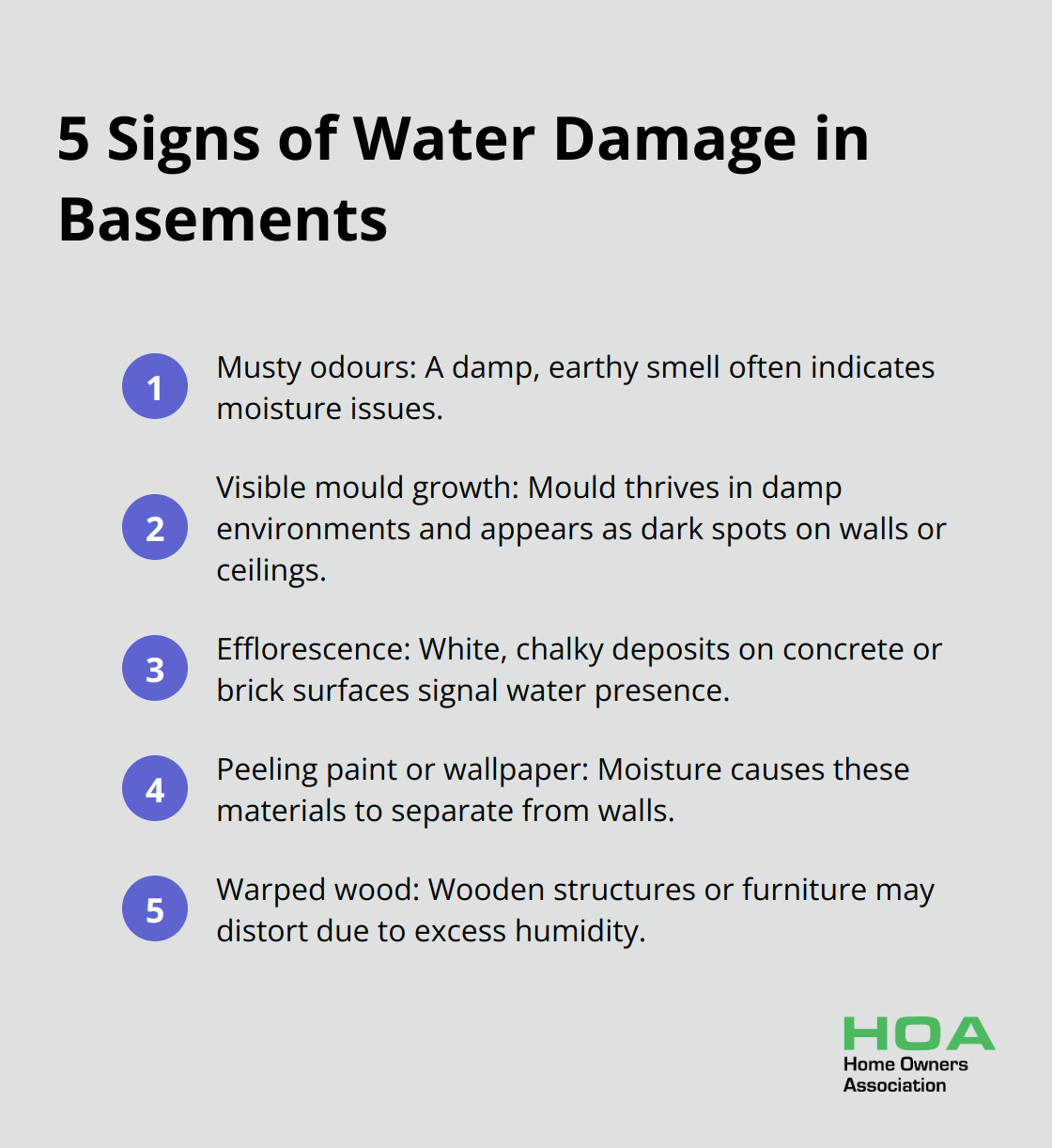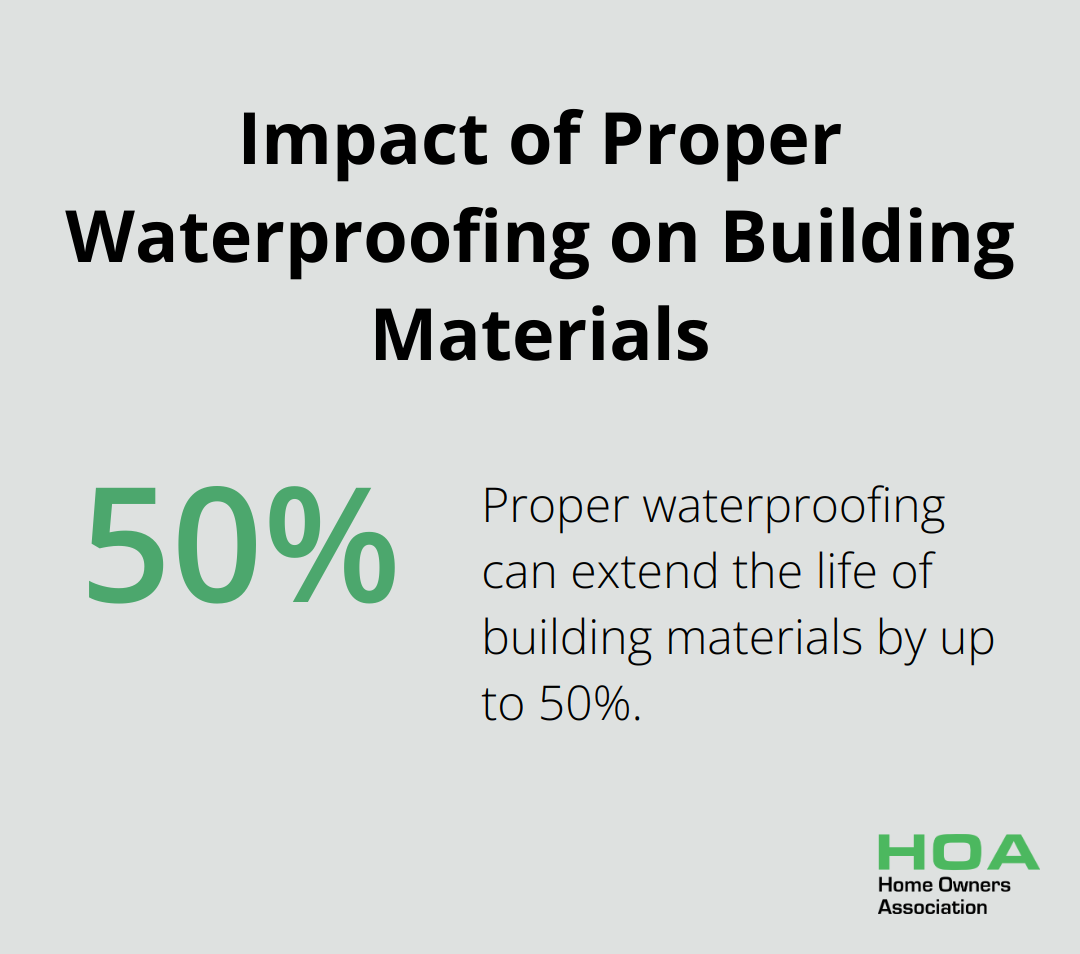
At Home Owners Association, we understand the importance of a dry basement for maintaining your home’s value and structural integrity. Basement waterproofing is a critical step in protecting your property from water damage and mould growth.
In this comprehensive guide, we’ll explore effective methods to keep your basement dry and secure. From identifying common water issues to implementing both exterior and interior waterproofing solutions, we’ve got you covered.
What Causes Basement Water Issues?
Common Sources of Water Intrusion
Basement water problems plague many homeowners across Australia. Understanding the primary causes of these issues is essential for effective prevention and mitigation.
Poor drainage around your home’s foundation often leads to water seepage. When rainwater or groundwater doesn’t flow away from your house properly, it can penetrate through cracks in your foundation walls or floor.
Faulty gutters and downspouts contribute significantly to basement water issues. Clogged gutters or downspouts that don’t direct water far enough from your home allow water to pool around the foundation and eventually find its way inside.
Hydrostatic pressure (which occurs when the water table rises) can force water through even the tiniest cracks in your basement walls or floor. This problem is particularly prevalent in areas with heavy rainfall or near bodies of water. For those who did well in physics at school, the formula is “P=pgh” or Pressure = Fluid Density x Acceleration due to gravity x Depth of fluid.
Signs of Water Damage
Early detection of water problems can save thousands in repair costs. Watch out for these telltale signs:

The Urgency of Prompt Action
Addressing water issues promptly is vital.
Ignoring these issues can result in serious structural damage, decreased property value, and health risks associated with mould growth.
Regular basement inspections (especially after heavy rains or snowmelt) are crucial. Catching and addressing water issues early protects your home and helps you avoid costly repairs.
The Role of Professional Assessment
While DIY inspections are valuable, professional assessments can uncover hidden issues. Experts use specialised equipment to detect moisture levels and identify potential weak points in your basement’s structure.
Home Owners Association recommends scheduling professional inspections at least once a year. Our network of qualified contractors can provide comprehensive evaluations and tailored solutions for your specific situation.
As we move forward, let’s explore effective exterior waterproofing methods that can significantly reduce the risk of water intrusion in your basement.
How to Waterproof Your Basement from the Outside
Exterior waterproofing forms your primary defence against basement water issues. This section explores effective methods to protect your home’s foundation from moisture intrusion.
Grading and Landscaping Techniques
Proper grading directs water away from your home’s foundation. The ground should slope away from your house at a rate of 1-2%. This gentle slope ensures water flows efficiently away from your foundation rather than pools around it.
For effective landscaping, create a swale-a shallow, graded channel that guides water away from your property. Plant water-loving vegetation in these areas to absorb excess moisture. Native Australian plants like Kangaroo Paw or Bottlebrush (known for their drought tolerance) excel in this role.
Gutter and Downspout Management
Your gutters and downspouts play a vital role in basement waterproofing. Clean your gutters at least twice a year (more often if you have overhanging trees). Use gutter guards to prevent debris buildup and ensure smooth water flow.
Downspouts should extend at least 1.5 metres away from your foundation. If space limits this, install underground downspout extensions or dry wells to disperse water safely away from your home.
Exterior Waterproofing Treatments
Apply a waterproof membrane to your foundation walls to prevent water intrusion. This process involves:
- Excavating the soil around your foundation
- Cleaning the walls
- Applying a thick, rubberised coating
For added protection, install a French drain system alongside your foundation. This perforated pipe, surrounded by gravel, collects and diverts groundwater away from your home.
The Australian Building Codes Board states that proper waterproofing can extend the life of your building materials by up to 50%. It’s an investment that pays off in the long run.

While DIY options exist, professional application of exterior waterproofing treatments often yields the best results. (Home Owners Association members have access to vetted contractors who specialise in these services, ensuring high-quality work and peace of mind.)
Exterior waterproofing provides robust protection, but it’s only part of a comprehensive strategy. The next section will explore interior waterproofing solutions to create a multi-layered defence against moisture intrusion.
Fortifying Your Basement from Within
Sump Pump Installation
A sump pump transforms basement waterproofing. This device, installed in a pit at the lowest point of your basement, pumps out accumulated water before it causes damage. Select a pump with sufficient horsepower for your basement size and expected water volume.
Install a sump pump with a battery backup. Power outages often coincide with severe weather, exactly when you need your pump most. Consider a pump with an alarm system to alert you of malfunctions.
Sealing Cracks and Applying Coatings
Even small cracks allow significant water intrusion over time. Inspect your basement walls and floor thoroughly for cracks, with special attention to corners and joints. Use hydraulic cement for hairline cracks. For larger fissures, epoxy injection systems offer a more permanent fix.
After addressing cracks, apply a waterproof coating to your basement walls and floor. Products like Drylock or Xypex (Home Owners Association recommends these as top choices) provide excellent protection against moisture penetration. These coatings form a barrier that withstands hydrostatic pressure, preventing water from seeping through concrete pores.
Moisture Control and Ventilation
Control humidity to prevent mould growth and maintain a dry basement environment. Install a quality dehumidifier capable of maintaining relative humidity below 50%. (For larger basements, multiple units or a whole-house dehumidifier work best.)
Proper ventilation complements your dehumidification efforts. Install exhaust fans to remove moist air and promote air circulation. Add windows or vents to allow natural airflow if possible. Ensure these openings are properly sealed to prevent water ingress during wet weather.
Interior Drainage Systems
Interior drainage systems offer an additional layer of protection. These systems collect water that seeps through walls or floors and channel it to the sump pump. Install a perimeter drain along the basement walls to capture water before it reaches the floor.
French drains, installed beneath the basement floor, provide another effective solution. These systems intercept groundwater and direct it to the sump pump, keeping your basement dry.
Waterproof Flooring Options
Consider waterproof flooring options for your basement. Epoxy floor coatings create a seamless, waterproof surface that resists moisture and chemicals. Interlocking plastic tiles or rubber flooring also provide excellent moisture barriers while adding comfort and insulation.
Final Thoughts
Basement waterproofing requires a comprehensive approach that combines exterior and interior methods. This dual strategy protects your home’s foundation and ensures a dry, healthy living Space. A properly waterproofed basement safeguards structural integrity, prevents mould growth, and increases property value.
Regular maintenance and inspections play a vital role in maintaining an effective basement waterproofing system. We recommend annual professional inspections to identify and address potential issues early (before they escalate into costly repairs). Basement waterproofing is an investment in your home’s future, providing peace of mind and long-term Savings.

Home Owners Association supports you throughout your basement waterproofing journey. Our network of qualified professionals provides expert guidance, quality materials, and reliable services to ensure your project’s success. With our resources and your commitment to maintenance, you can enjoy a dry, secure basement for years to come.





